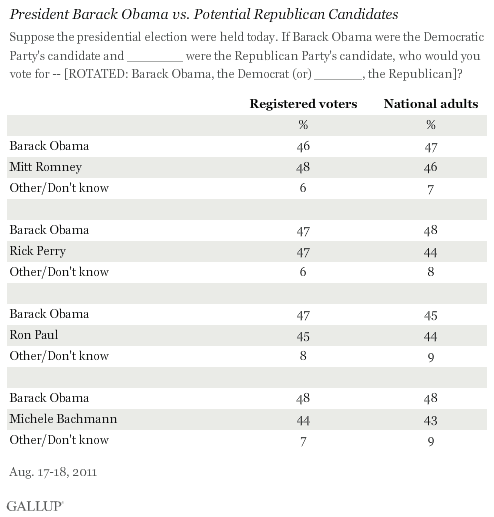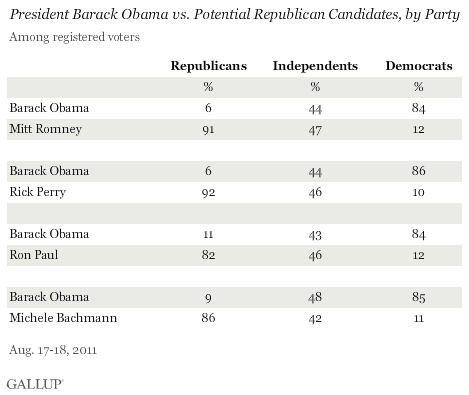PRINCETON, NJ -- President Barack Obama is closely matched against each of four possible Republican opponents when registered voters are asked whom they would support if the 2012 presidential election were held today. Mitt Romney leads Obama by two percentage points, 48% to 46%, Rick Perry and Obama are tied at 47%, and Obama edges out Ron Paul and Michele Bachmann by two and four points, respectively.

These prospective election ballots -- measured Aug. 17-18, well over a year before the Nov. 6, 2012, election -- indicate that the race for president at this point is generally competitive, with voters fairly evenly divided in their preference for giving Obama a second term or electing a Republican candidate. Even though the four Republican candidates tested have varying degrees of name recognition, they all fare roughly the same.
Gallup's generic presidential ballot -- measured six times this year -- shows a close race between Obama and a generic "Republican presidential candidate," although there have been survey-to-survey variations on this measure, with the Republican candidate leading in June and July.
President Obama's job approval rating is hovering around the 40% mark. This is below the rating that any of the six incumbent presidents re-elected since Eisenhower has had at the time of the presidential election. However, in August of the year before they were re-elected, Ronald Reagan (43%) and Bill Clinton (46%) were both below 50%. Obama's position of rough parity against leading GOP candidates shows that more Americans at the moment say they would vote for Obama than approve of the job he is doing -- perhaps a reflection of the continuing lack of a strong front-runner on the Republican side.
With the first official votes for the Republican nomination more than five months away, and with the very real possibility that GOP candidates such as Sarah Palin, Rudy Giuliani, and George Pataki may jump into the race, much could still change as the election process unfolds. A look at presidential election trial heats conducted in the late summer of the year before previous elections reveals that such change is quite common:
- In August 1999, Texas Gov. George W. Bush led Vice President Al Gore by 55% to 41% in a Gallup trial heat poll. That race ended up in a virtual dead heat, with Gore ultimately winning slightly more of the national popular vote than Bush.
- In August 1995, Kansas Sen. Bob Dole was slightly ahead of President Bill Clinton in a Gallup poll, 48% to 46%. On Election Day 1996, Clinton beat Dole by eight points.
- In August 1983, President Ronald Reagan was ahead of Democrat Walter Mondale by only one point, 44% to 43%. Reagan went on to beat Mondale in a 59% to 41% landslide in the November 1984 election.
- In August 1979, incumbent President Jimmy Carter was tied with former California Gov. Reagan -- each getting 45% of the vote. Reagan ultimately defeated Carter by 10 points.
Voters Favor Their Party, but Republicans Lend Less Support to Bachmann, Paul
Democratic and Republican registered voters display strong allegiance for their party's candidate across these election match-ups. Democrats are the most consistent, voting for Obama to about the same degree regardless of who the GOP candidate is. Republicans exhibit a little more variation, giving their strongest support to Perry (92% would vote for him) and Romney (91%), weaker support to Bachmann (86%), and the weakest support to Paul (82%). Independents tilt at least slightly toward voting for Romney, Perry, and Paul against Obama, while tilting slightly toward Obama when he is pitted against Bachmann.

Bottom Line
President Obama is at the moment in a rough parity position when registered voters are asked whether they would vote for him in election matchups against four potential Republican candidates. Romney fares slightly better than the other GOP candidates, and Bachmann slightly worse, but these are not large differences. Gallup research shows that these types of election measures at this stage in the campaign are not highly stable, and one can expect changes in the relative positioning of Obama and various GOP candidates in the months ahead.
Survey Methods
Results are based on telephone interviews conducted as part of Gallup Daily tracking survey Aug. 17-18, 2011, with a random sample of 1,026 adults, aged 18 and older, living in all 50 U.S. states and the District of Columbia.
For results based on the total sample of national adults, one can say with 95% confidence that the maximum margin of sampling error is ±4 percentage points.
For results based on the total sample of 879 registered voters, one can say with 95% confidence that the maximum margin of sampling error is ±4 percentage points.
Interviews are conducted with respondents on landline telephones and cellular phones, with interviews conducted in Spanish for respondents who are primarily Spanish-speaking. Each sample includes a minimum quota of 400 cell phone respondents and 600 landline respondents per 1,000 national adults, with additional minimum quotas among landline respondents by region. Landline telephone numbers are chosen at random among listed telephone numbers. Cell phone numbers are selected using random-digit-dial methods. Landline respondents are chosen at random within each household on the basis of which member had the most recent birthday.
Samples are weighted by gender, age, race, Hispanic ethnicity, education, region, adults in the household, and phone status (cell phone only/landline only/both, cell phone mostly, and having an unlisted landline number). Demographic weighting targets are based on the March 2010 Current Population Survey figures for the aged 18 and older non-institutionalized population living in U.S. telephone households. All reported margins of sampling error include the computed design effects for weighting and sample design.
In addition to sampling error, question wording and practical difficulties in conducting surveys can introduce error or bias into the findings of public opinion polls.
For more details on Gallup's polling methodology, visit www.gallup.com.
